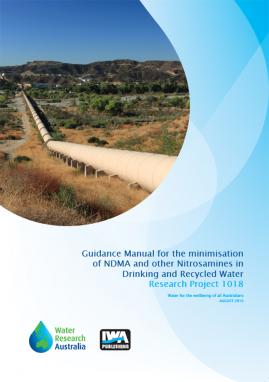 |
Guidance Manual for the Minimisation of NDMA and other Nitrosamines in Drinking and Recycled Water
Guidance Manual for the Minimisation of NDMA and other Nitrosamines in Drinking and Recycled Water

N‐nitrosodimethylamine (NDMA) is a nitrogen‐containing organic compound that has known carcinogenic properties. NDMA has been a health concern for some industries for a number of years as it is used in rubber formulations, as a fire retardant, antioxidant, additive for lubricants and softener of copolymers; it is also a degradation product of dimethylhydrazine, an additive to rocket fuel. Most people are exposed to NDMA via a number of diverse routes including cigarette smoke (actively or passively) and processed foods, for example smoked meat products. However, it has only come to the attention of the international water industry since it was recognised as a disinfection by‐product (DBP) of chloramination or chlorination in the presence of ammonia.
The aim of this guidance manual is to answer commonly asked questions about this
emerging issue, such as:
• How do they come to be in drinking water and recycled water and what
• concentrations are “normal”?
• What regulatory/guidance levels have been imposed in Australia and elsewhere?
• How are they formed? What are the risk factors for the occurrence of nitrosamines in my system?
• What can we do to control them?
• What are the implications for the drinking and recycled water industry, and in particular for public health?
This Guidance Manual has a companion document, Generic Management Plan for Nitrosamines in Drinking Water which provides provide background information on the group of organic contaminants, nitrosamines.
This book is co-published with Water Research Australia .
Also available as part of your Water Inteligence Online subscription
Publication Date: 01/02/2014ISBN13: 9781780406220eISBN: 9781780406237Pages: 27 |
Print:
|